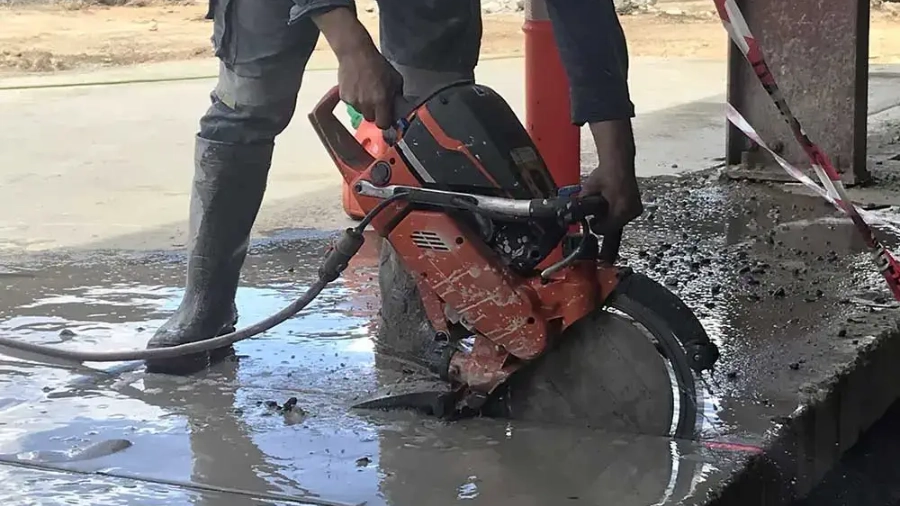Professional contractors use wet cutting concrete and dry cutting concrete techniques for specific applications. The former is appropriate for slicing thick or reinforced concrete, while the latter is suitable for shallow cuts and areas with little water access. Depending on the project requirements, each method has unique advantages and disadvantages that compel technicians to select the proper approach.
This blog will delve deeper into the advantages and disadvantages of wet cut concrete and dry concrete cutting to provide clients with knowledge on the appropriate technique for their project requirements.
What Is Wet Cutting?
This technique uses wet saw concrete cutting equipment with water-cooled diamond blades. The apparatus sprays water directly on the concrete surface to prevent blade warping and operates at high revolutions per minute (RPM), allowing it to cut longer. Wet cutting saws can either be diesel- or gasoline-operated and work best on the following applications:
- Thick or reinforced concrete
- Projects in open or outdoor areas
- Applications that require accurate, clean cuts
- Projects prioritising dust reduction
Wet Cutting Advantages
The advantages of wet cutting include the following:
- Precision: Manufacturers design these blades for precise, accurate cuts on thick, reinforced concrete and resilient, sensitive materials.
- Speed: Wet cutting finishes projects faster than its dry counterpart, For instance, the former can finish sidewalk or driveway cutting in one to two days and accomplish slab or floor cutting in two to five days.
- Cost-effective: Users aren’t required to replace wet cutting blades frequently, so clients save more money over time.
- Safety: Water usage significantly reduces dust and prevents respiratory health issues. This water-based cutting technique also minimises overheating-related safety hazards.
- Noise reduction: Wet cutting produces less noise and vibrations than dry cutting, minimising disruptions and annoyances for surrounding neighbourhoods.
Wet Cutting Disadvantages
The disadvantages of wet cutting include the following:
- Water supply reliance: Wet cutting in areas with sparse water can be challenging. This inconvenience can delay project timelines and completions.
- Shorter lifespan: Although wet cutting blades are more cost-effective, they have a shorter lifespan than dry cutting.
- Messy: Water sprays can combine with adjacent substances, such as dust, creating messy concrete sludges. Contractors must clean them to eliminate potential safety hazards.
- Electrical hazard: Water can create hazards with electrical equipment. As trusted Brisbane hand & ring sawing experts with over two decades of valuable industry experience, we strongly recommend installing water-susceptible machinery in the work area before proceeding.
What Is Dry Cutting?
Dry cutting uses a specific, heat-resistant blade to slice through concrete and other surfaces. Technicians use low-horsepower handheld saws for smaller projects.
Dry cutting equipment relies on surrounding air to cool down the blades. Hence, it free spins between cuts to maximise airflow and preserve the cutting mechanism. Some contractors use dry-cutting saws with a dust extractor or vacuum to prevent the dust from spreading to the work area.
Dry cutting is appropriate for the following applications:
- Indoor cutting and renovations
- Small-scale cutting projects
- Concrete block, brick, or paver cutting
- Cold or Water-restricted areas
- Asphalt and soft concrete cutting
Dry Cutting Advantages
The advantages of dry cutting include the following:
- Straightforward use: Since dry cutting equipment has more limitations than wet versions, the former creates shallow, straight cuts for small-scale projects.
- Portability: Many dry-cutting saws don’t require power sources, allowing technicians to use them freely and easily.
- Clean surroundings: Dry-cutting saws don’t spray water and create concrete sludge, helping streamline project operations and preventing cleaning-related delays.
- Resiliency: Dry-cutting blades’ resilient and heat-resistant features help withstand friction and wear and tear and prevent warping or cracking. Their long lifespans allow them to complete numerous, diverse projects.
Dry Cutting Disadvantages
The disadvantages of dry cutting include the following:
- Dust: Dry cutting produces dust, which can cause respiratory health issues. As experienced Australian concrete cutting experts, we encourage the use of dust vacuums and dust extractors to enhance safety and minimise this possibility.
- Limited orientation: Dry-cutting blades cannot produce curved, circular, or angular cuts, significantly limiting their capabilities in landscaping or decorative concrete applications.
- Possible delays: Since this technique can only perform straight-line cuts, contractors may need additional tools, such as wet saws, angle grinders, or jigsaws, to complete the project. Unfortunately, more tools may result in significant delays or disruptions.
- Prolonged operation: Dry cutting takes longer than wet techniques and requires more downtime.
Conclusion
When deciding on the best concrete cutting method for residential or commercial projects, it’s crucial to consider numerous factors, such as precision, speed, safety, cost-effectiveness, and efficiency. This knowledge will empower clients to make enlightened decisions for their specific requirements.
Blade handling is one of the most glaring differences between the two methods. Technicians can use handheld dry-cutting saws for small-scale projects. On the other hand, wet cutting requires consistent, smooth handling to prevent chipping or binding. Reliance on water makes this method challenging in areas with sparse water supplies, limiting its potential and efficiency.
As Brisbane floor and road sawing experts with over two decades of experience, we strongly recommend considering your project’s scope, magnitude, and demands before choosing your preferred cutting technique.


